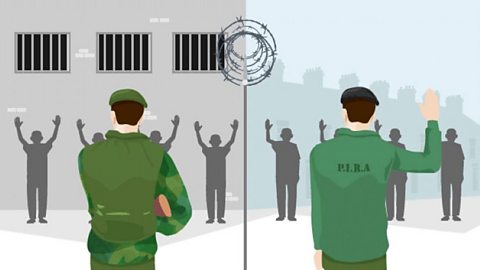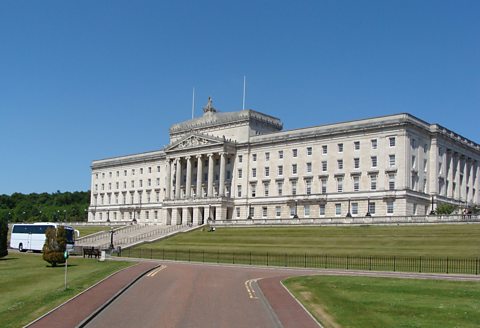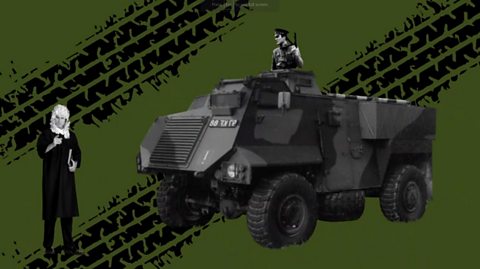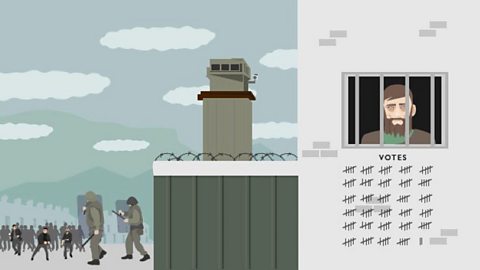A split in the IRA
As paramilitary groups began to grow in size and support, splits began to emerge within some of them.
‚ÄėI Ran Away‚Äô was an accusation levelled at the Irish Republican Army (IRA)A republican paramilitary group which was determined to create an Irish Republic as proclaimed in the 1916 Easter Rising. because of its failure to defend Catholics during the violence of 1969.
Since the ending of its border campaignA campaign of violence waged by the Irish Republican Army (IRA) against targets in Northern Ireland which lasted from 1956 to 1962. in 1962, the IRA had become more interested in MarxistThe ideas of Karl Marx who supported a system of rule where industries were run by the government for the good of the people..
However, some of its younger members were unhappy with this and wanted to take matters into their own hands, particularly the defence of nationalistPeople who believe their country should be independent from other nations. For example, Irish nationalists, who want Ireland to be fully independent of Britain. areas.
Towards the end of 1969, therefore, the IRA membership split and two new groups emerged: the Official IRA (OIRA) and the Provisional IRA (PIRA).
The IRA border campaign ended in 1962
Republican paramilitaries
The Official IRA (OIRA)
Made up mainly of older Irish Republican Army (IRA)A republican paramilitary group which was determined to create an Irish Republic as proclaimed in the 1916 Easter Rising.members.
More interested in setting up an Irish republicA country which is not ruled by a king or queen. that would be run along MarxistThe ideas of Karl Marx who supported a system of rule where industries were run by the government for the good of the people. lines.
Not as involved in the use of violence as the Provisional Irish Republican Army (PIRA)Irish republican paramilitary group formed when members split from the Official IRA (OIRA) in 1969., but until the group declared a ceasefire in May 1972 they still regarded violence as an option.
Two years later there was a further division within the OIRA with the more militantUsing strong or violent action in support of a political cause. Irish Nationalist Liberation Army (INLA) being set up.
This group was supported by a political wing, the Irish Republican Socialist Party (IRSP).
The Provisional IRA (PIRA)
- Members believed that the Official IRA (OIRA) hadn’t done enough to protect the nationalistPeople who believe their country should be independent from other nations. For example, Irish nationalists, who want Ireland to be fully independent of Britain. community during the violence of the previous summer.
- With a younger membership, the Provisional Irish Republican Army (PIRA)Irish republican paramilitary group formed when members split from the Official IRA (OIRA) in 1969. saw itself as the defender of the minority community within Northern Ireland.
Towards the end of March 1970, the PIRA set out its objectives.
These were:
- The protection of the Catholic population.
- The achievement of civil rights Rights everyone is entitled to regardless of the colour of their skin, their beliefs, sexuality, sex or other personal characteristics. These rights could include - amongst other things - the right to vote, the right to free speech or the right to a good education..
- The destruction of the Northern Ireland Government.
- The creation of an Ireland free from British imperialismA system in which one country rules over other countries or territories, often by invasion or exerting power..
Loyalist paramilitaries
Paramilitary groups also began to emerge from within the Protestant community.
Two groups in particular began to gain prominence.
The Ulster Volunteer Force (UVF)
The Ulster Volunteer Force was by no means a new organisation. It could trace its origins back to the campaign against the Third 91»»Ī¨ Rule BillIntroduced into the Westminster Parliament in 1912, this Bill aimed to set up a 91»»Ī¨ Rule Parliament in Dublin..
The UVF:
- Re-emerged in the mid-1960s and grew in size as Northern Ireland Civil Rights Association’s campaign for civil rights Rights everyone is entitled to regardless of the colour of their skin, their beliefs, sexuality, sex or other personal characteristics. These rights could include - amongst other things - the right to vote, the right to free speech or the right to a good education. gained momentum.
- Re-emerged due to anger at the implications for Protestants of O’Neill’s reform programme.
- Believed that the ideal future lay in turning back the clock to the days of absolute unionist control of Northern Ireland.
- Sought to oppose the actions of Irish republicanA person who wants to establish an all Ireland republic completely independent of Britain. paramilitaryA person or organisation that operates like a military force, but is not part of a country's official armed forces. and to ensure that Northern Ireland remained a part of the United Kingdom.
The Ulster Defence Association (UDA)
The Ulster Defence Association (UDA) was established in September 1971.
It:
- Aimed to defend loyalistA person who, in terms of culture, identity and politics, retains a strong loyalty to Britain and firmly opposes a united Ireland. areas from attacks by Irish republicanA person who wants to establish an all Ireland republic completely independent of Britain. paramilitaryA person or organisation that operates like a military force, but is not part of a country's official armed forces..
- Soon became very popular and within a year could claim a membership in excess of 30,000.
- Its size meant that the authorities saw the UDA as too large to ban.
Although the UDA was involved in attacks on members of the nationalist community, it remained a legal organisation for almost twenty years.
When such attacks took place, they were claimed using a cover name, the Ulster Freedom Fighters (UFF).
The UFF was outlawed in 1973.
The IRA and the British Army
When the British Army was first ordered on to the streets of Northern Ireland it was welcomed by members of the nationalistPeople who believe their country should be independent from other nations. For example, Irish nationalists, who want Ireland to be fully independent of Britain. community.
They viewed them as their protectors from what was seen as the biasPreference for or against one person or group. of Northern Ireland’s police force, the Royal Ulster Constabulary (RUC)Police force in Northern Ireland from 1922 to 2001..
Their arrival was also considered to be a rejection by the British government of the security policy followed by the Stormont administration.
The Army, however, soon found itself in a difficult situation.
As the Provisional Irish Republican Army (PIRA)Irish republican paramilitary group formed when members split from the Official IRA (OIRA) in 1969. campaign of violence to achieve its aims took off in the early part of 1970, it became clear that sooner or later the group would target the British Army as the symbol of British imperialismA system in which one country rules over other countries or territories, often by invasion or exerting power. in Ireland.
The Army decided to act to stop the PIRA growing too strong.
Falls Road curfew
One of its first strategies was the imposition of a military curfewA government/military order that states that people must be off the streets by a certain time. on the nationalistPeople who believe their country should be independent from other nations. For example, Irish nationalists, who want Ireland to be fully independent of Britain. Falls Road area of Belfast.
This curfew ‚Äď which took place in early July and which lasted for thirty four hours ‚Äď was designed to allow thorough house-to-house searches for weapons and ammunition.
Locally this became known as ‚ÄėThe rape of the Falls‚Äô.
In many ways, the curfew was a disaster for the Army.
Although some explosives, guns and ammunition were uncovered, the inconvenience of the curfew and the damage caused during the searches meant that:
- The Army’s positive relationship with the nationalist community was fatally damaged.
- Provisional Irish Republican Army (PIRA)Irish republican paramilitary group formed when members split from the Official IRA (OIRA) in 1969. membership increased.
Another new Prime Minister
Throughout the rest of 1970 and into 1971, Northern Ireland witnessed growing levels of violence and destruction.
In response, the Northern Ireland Government begged the new Conservative Government in London to take a stronger line.
This did not happen - the British Government did not want to damage its relationship with the nationalistPeople who believe their country should be independent from other nations. For example, Irish nationalists, who want Ireland to be fully independent of Britain. community even further.
Eventually, Chichester Clark became so frustrated that, on 20th March 1971, he resigned as Prime Minister.
Following a short leadership campaign within the Ulster unionistA person who believes the union between Britain and Northern Ireland should continue. Party, Minister of Development Brian Faulkner defeated William Craig for the Party leadership and was duly appointed Prime Minister of Northern Ireland.
WATCH: The re-emergence of paramilitary organisations
Test your knowledge
More on Changing relations: Northern Ireland and its neighbours, 1965-98
Find out more by working through a topic
- count5 of 11

- count6 of 11

- count7 of 11

- count8 of 11
